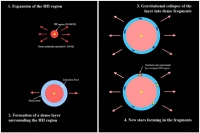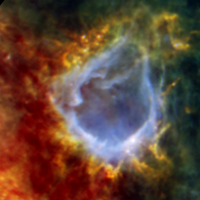Herschel unveils rare massive stars in the act of forming
6 May 2010
New images from ESA's Herschel space observatory reveal high-mass protostars around two ionised regions in our Galaxy. The detection of these rare stars in an early phase of evolution is key to understanding the mysterious formation of massive stars.This is one of the many discoveries presented this week at the Herschel First Results Symposium, ESLAB 2010, held at the European Space Research and Technology Centre, Noordwijk, The Netherlands.
Massive stars are the rare birds of astrophysics. With a mass over eight times that of the Sun, these stars are much less common than their lower-mass counterparts. In addition, they are short-lived, consuming their nuclear fuel at a rapid rate before ending their life in spectacular manner as a supernova. Their scarcity means that observations of these rare giants can prove difficult to obtain, but characterising these elusive objects is essential for understanding the chemical and dynamical evolution of galaxies.
|
RCW 120 as seen by Herschel. Credit: ESA, PACS & SPIRE Consortia, A. Zavagno (Laboratoire d'Astrophysique de Marseille) for the Herschel HOBYS and Evolution of Interstellar Dust Key Programmes |
One theory that has been put forward predicts that massive stars form at the outskirts of HII regions. An HII region is a bubble of hot hydrogen gas which has been ionised by the powerful radiation emitted by a central massive star formed in a previous generation. Temperature differences between the interior (up to 10 000 Kelvin) and the surrounding material (cooler than 100 Kelvin) cause these bubbles to expand and to reach supersonic speeds. This expanding bubble sweeps up a layer of neutral material around it, which then fragments into the dense seeds of a new generation of high-mass stars.
New data from Herschel targeting two distinct HII regions in our Galaxy, namely RCW 120 and N49, yield strong evidence in favour of this scenario. Thanks to its unprecedented resolution and sensitivity over a wide range of infrared wavelengths, ESA's new space observatory has imaged, for the first time, a handful of very young, massive stars on the border of both regions. These objects, which came to life less than a few tens of thousands of years ago, have never before been observed.
"We can finally witness the long-sought-after triggered formation of massive stars," says Annie Zavagno from Laboratoire d'Astrophysique de Marseille. "The high density of the material surrounding these bubbles and the intense motions due to stellar winds might be responsible for this particularly efficient star-forming process, leading to a new population of more massive stars around them."
 |
|
The 'collect and collapse' model. Credit: Deharveng & Zavagno |
Particularly striking is the discovery, around RCW 120, of a massive protostar with a mass 8-10 times larger than the Sun's. "This object appears to be surrounded by a huge envelope of about 2000 solar masses, and it will continue to grow into an even more massive fully-fledged star," adds Zavagno.
Over the course of the next few months, PACS and SPIRE will target several other galactic HII regions that exhibit evidence of triggered star formation, in order to study this process in greater detail and to shed new light on the mechanisms producing high-mass stars in our Galaxy.
Notes to Editors
Herschel is an ESA space observatory with science instruments provided by European-led Principal Investigator consortia, with important participation from NASA.
PACS is an imaging photometer and integral field line spectrometer covering wavelengths between 57 and 210 µm. PACS was built by a consortium of institutes and university departments from across Europe, and is led by Albrecht Poglitsch of the Max-Planck-Institute for Extraterrestrial Physics, Garching, Germany. Consortium members are: UVIE (Austria); KUL, CSL, IMEC (Belgium); CEA, OAMP (France); MPIA (Germany); IFSI, OAP/AOT, OAA/CAISMI, LENS, SISSA (Italy); IAC (Spain). This development has been supported by the funding agencies BMVIT (Austria), ESA-PRODEX (Belgium), CEA/CNES (France), DLR (Germany), ASI (Italy), and CICYT/MCYT (Spain).
The SPIRE instrument comprises an imaging photometer (camera) and an imaging spectrometer. The camera operates in three wavelength bands centred on 250, 350 and 500 μm, and so can make images of the sky simultaneously in three submillimetre “colours”. The spectrometer covers the range 200 – 670 μm, allowing the spectral features of atoms and molecules to be measured. SPIRE has been developed by a consortium of institutes led by Cardiff Univ. (UK) and including Univ. Lethbridge (Canada); NAOC (China); CEA, LAM (France); IFSI, Univ. Padua (Italy); IAC (Spain); Stockholm Observatory (Sweden); Imperial College London, RAL, UCL-MSSL, UKATC, Univ. Sussex (UK); Caltech, JPL, NHSC, Univ. Colorado (USA). This development has been supported by national funding agencies: CSA (Canada); NAOC (China); CEA, CNES, CNRS (France); ASI (Italy); MCINN (Spain); SNSB (Sweden); STFC (UK); and NASA (USA). The consortium is led by Professor Matt Griffin of Cardiff University.
The results reported here are based on a subset of observations from the following Herschel Key Programmes: HOBYS: the Herschel imaging survey of OB Young Stellar objects, led by Principal Investigator Frédérique Motte (SAp/CEA Saclay, France); Evolution of Interstellar Dust, led by Principal Investigator Alain Abergel (Institut d'Astrophysique Spatiale, IAS, France); and Hi-GAL: the Herschel Infrared Galactic Plane Survey, led by Principal Investigator Sergio Molinari (IFSI-INAF, Italy).
Related publications
Zavagno, A., et al., "Star formation triggered by the Galactic HII region RCW 120", 2010
Zavagno, A., et al., "Star formation triggered by HII regions in our Galaxy", 2010
Both papers will appear in a special issue of the journal Astronomy & Astrophysics dedicated to Herschel's first results.
Contacts
Annie Zavagno
Laboratoire d'Astrophysique de Marseille, France
Email: annie.zavagno oamp.fr
oamp.fr
Phone: +33-4-95-04-41-55
Göran Pilbratt, Herschel Project Scientist
Research and Scientific Support Department
Science and Robotic Exploration Directorate, ESA, The Netherlands
Email: gpilbratt rssd.esa.int
rssd.esa.int
Phone: +31-71-565-3621


